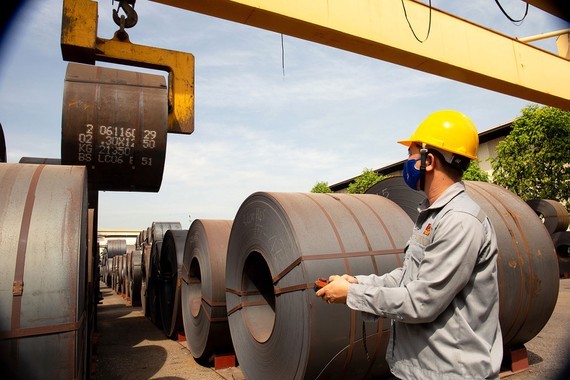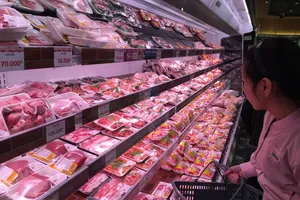 Sheet metal is imported to produce finished products for the market. (Photo: SGGP)
Sheet metal is imported to produce finished products for the market. (Photo: SGGP)
Exporting raw materials, importing refined products According to statistics, up to 60-80 percent of raw materials for production of domestic industries depend on imported supplies. Not only facing the disruption of the global supply chain, leading to high prices of raw materials, but the internal strength of domestic enterprises is also inherently weak, so they have to purchase raw materials quarterly. According to a report of the General Statistics Office of Vietnam (GSO), 13 items serving domestic production activities saw an imported value of over $1 billion, accounting for 71.9 percent of the total import turnover. Electronics, computers, and components had the highest trade deficit of $5.77 billion, followed by plastic raw materials with $1.7 billion, chemical products with $1.1 billion, chemicals with nearly $1 billion, gasoline with $848 million, raw materials for textile, garment, and footwear with $665 million, and iron and steel with $602 million. According to Mr. Mai Dinh Cong Khuong, Chairman of the Board of Members of Khuong Mai Steel Trading and Service Co., Ltd., from the beginning of the year to now, the prices of raw materials from iron ore, coke, and scrap steel have increased sharply globally, pushing up steel billet price to climb by 20-30 percent compared to the end of 2021. Therefore, the company has no way to control the price increase because 100 percent of the company's raw materials are imported. Regarding the above issue, Mr. Vu Duc Giang, Chairman of the Vietnam Textile and Apparel Association, said that 60 percent of raw fabrics must be imported from China. Lately, to diversify the supply of raw materials and, at the same time, increase the possibility to enjoy the preferential tax rates from FTAs, domestic enterprises have switched to importing raw materials from Europe, the US, South Korea, and Japan. However, the prices of imported materials from these markets are 15-30 percent higher than those of China. Not to mention that due to the impact of the pandemic from 2021 to now, raw material prices in all import markets have simultaneously soared by 1-3 times, depending on the product category.Tired of waiting for local raw materials According to Mr. Tran Viet Anh, purchasing domestic raw materials is always the desire of all plastic manufacturers. If the proportion of domestic materials is increased, enterprises will not only proactively make their production plans, and reduce logistics costs but also increase their competitiveness, thanks to the preferential export tax when exporting to markets that have signed the FTAs, including the European and US markets. The dependence of domestic enterprises on imported raw materials is not something new. However, for many years, the necessary proposals to gain autonomy in the source of raw materials have not been resolved. Mr. Pham Xuan Hong, Chairman of the Ho Chi Minh City Association of Garments, Textiles, Embroidery, and Knitting, analyzed that investing in a cut and sew factory needs about VND1 trillion, but investing in fabric production needs billions of US dollars. That is why most domestic enterprises cannot afford to invest in raw material production. Mr. Do Phuoc Tong, Chairman of HCMC Association of Mechanical - Electrical Enterprises, said that for enterprises producing supporting industry products, building a steel factory is just a dream. “I dare not think about the huge amount of money needed to invest in a steel material factory. Therefore, the lack of raw materials is a common thing that most enterprises in the industry have to endure. Currently, enterprises have to renegotiate with their suppliers. If we cannot compete in price, we have to give up market share to other supply partners," Mr. Do Phuoc Tong lamented. From another perspective, many enterprises said that investment incentives for foreign enterprises in recent years had attracted many raw material manufacturers to invest in Vietnam. However, raw materials produced by these manufacturers are then supplied to their parent companies in a closed process, so domestic enterprises cannot access this source of raw materials. Meanwhile, domestic enterprises with good internal resources need technology transfer to invest in raw material production, but not all FDI enterprises are willing to do so. Faced with the above fact, enterprises believe that, for domestic enterprises to have raw materials for production, authorities need to have conditions attached to the foreign investment attraction policy in the field of raw material production. It is essential to stipulate the priority rate of raw material supply for domestic enterprises. At the same time, it is necessary to provide financial support for leading enterprises to create a foundation for the establishment of a closed domestic supply chain of Vietnamese enterprises, supporting each other for sustainable development.
Diversifying supply markets for raw materials
Chairman of the Vietnam Textile and Apparel Association Vu Duc Giang said that in the context that enterprises still have to continue to depend on imported raw materials, the Ministry of Industry and Trade needs to effectively promote the role of foreign trade counselors. For instance, they should strengthen the search for raw material supply markets, support enterprises to access reliable and good-priced sources of supply to support internal competitiveness for enterprises, and at the same time, minimize the risks of dependence on a sole supply market or supply disruption, causing production disruption.
Chairman of the Vietnam Textile and Apparel Association Vu Duc Giang said that in the context that enterprises still have to continue to depend on imported raw materials, the Ministry of Industry and Trade needs to effectively promote the role of foreign trade counselors. For instance, they should strengthen the search for raw material supply markets, support enterprises to access reliable and good-priced sources of supply to support internal competitiveness for enterprises, and at the same time, minimize the risks of dependence on a sole supply market or supply disruption, causing production disruption.
























